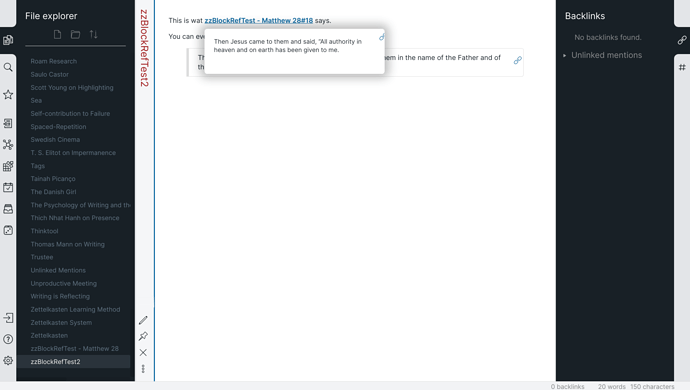Again, a fascinating topic that really stimulates my own thoughts, and I’d like to contribute.
It appears the debate on block referencing has quite a bit of focus on the mechanics of how it could be achieved, with perhaps more than some comparisons to Roam and some probing as to why you would, or wouldn’t want to do it.
Apologies for Stating the Obvious
If we consider the essence of the use-case where we want to achieve a graph of linked thoughts, each thought in Roam is, at it’s most atomic, a single bullet. This is conveniently lazy (not meant to be pejorative) in that we could ‘brain dump’ in our daily note page with all kinds of links and the subsequent nodes of the thought graph would all reflect the thoughts we had - because bullet node links to bullet node.
In Obsidian, each thought (node) is either an .md file or a header within that file. Thus the same brain dump in our daily notes file would yield connections that all backlink to the daily file - which has a certain utility, like when you want to recall when you had a particular brain-wave, but isn’t a real robust knowledge graph.
In Roam I’ve noticed most all of the thought ‘pages’ I’ve seen in examples - confession: I’m not a Roam user - are empty save for all the backlinks, which i where the magic happens.
In Obsidian this cannot be - well it could, but it wouldn’t be terribly useful. Pages link to pages or headers in pages.
@Silver and @Licat are showing us we need to be more deliberate in expressing our thoughts - which is hard, at least for me, which is why I keep reading everyone’s posts for inspiration  .
.
I’m Making This up as I Go
Since pages are file names, we are constrained by OS rules as to legal characters and length. This is where header referencing and multi-page panes are our friends.
If we want to brain-dump in our daily files, we could briefly pause to consider the topic or context of our thought, quickly link to that [[topic or context]], immediately open it in a new pane and dump our thought in there, which may contain further links - in which case, rinse-and-repeat.
We can then if we want to further contextualize our thought, place it under a header. We can add the header to our original link [[topic or context#further context]]. At that point we can be as wordy as we want since the header isn’t constrained by OS file-naming rules.
We preserve the initial link to when we had the thought, but we are also creating a knowledge graph, from the thought itself, by populating the thought page with the substance of the thought and links to further thoughts.
A Feature to be Requested
I’ve noticed though that if we preempt the header before it’s created - [[topic or context#further context not-yet-created]] and click to the page to create it, the header is not created.
Further, as @Lachlan points out, while file name changes are reflected in all links, header changes are not. And while what I have outlined is deliberate/intentional thought mapping - I’m going to have to try it myself today  - I would think having to manually change header links, after we have carefully revised our thought-map, would just get in the way and cause a break in our focus - counterproductive.
- I would think having to manually change header links, after we have carefully revised our thought-map, would just get in the way and cause a break in our focus - counterproductive.



 .
.